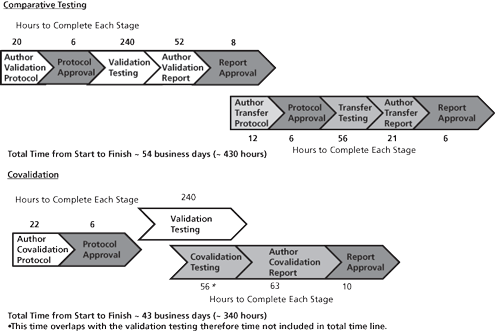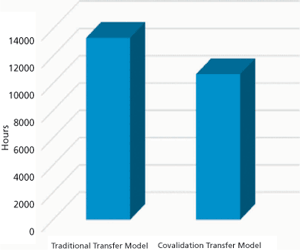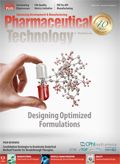Covalidation Strategies to Accelerate Analytical Method Transfer for Breakthrough Therapies
The primary impact of using the covalidation model is the expedited analytical method qualification of both the transferring and receiving laboratories.
Peer-Reviewed:
Submitted: May 27, 2016. Accepted: June 24, 2016.
Abstract
An important operation in the registration approval of a new drug product is the commercial-scale validation campaign at a receiving manufacturing site, which requires the technology transfer of analytical methodology from the transferring site. Traditionally, Bristol-Myers Squibb (BMS) used the comparative testing technology transfer model. In a recent launch of a product with breakthrough designation status, however, BMS used the covalidation technology transfer model, which involves simultaneous method validation and receiving site qualification. The authors describe the development and implementation of covalidation strategies to accelerate analytical method transfer using examples from a pilot study.
TOTOJANG1977/SHUTTERSTOCK.COM

In today’s challenging business environment, the speed of launch to the market for new drug products is crucial. The FDA Safety and Innovation Act of 2012 established a breakthrough designation program (1) to expedite the development and approval of innovative drugs for serious and life-threatening conditions. This program has resulted in biopharmaceutical companies prioritizing research on potential breakthrough drug entities and reviewing and assessing business practices to identify opportunities to speed up the development and registration process.
Within the pharmaceutical industry, method transfer is an integral part of the lifecycle of an analytical method (2). The United States Pharmacopeia (USP) defines the transfer of analytical procedures (TAP) as “the documented process that qualifies a laboratory (the receiving unit) to use an analytical test procedure that originates in another laboratory (the transferring unit, also named the sending unit), thus ensuring that the receiving unit has the procedure knowledge and ability to perform the transferred analytical procedure as intended” (3). The comparative testing technology transfer model involves initial validation of the analytical method at the transferring site, followed by subsequent transfer of the method to the receiving site. The covalidation technology transfer model involves simultaneous method validation and receiving site qualification.
Covalidation is based on the premise that the laboratory that completes the validation of an analytical procedure is qualified to run the procedure. According to USP <1224>, “the transferring unit can involve the receiving unit in an interlaboratory covalidation, including them as a part of the validation team, and thereby obtaining data for the assessment of reproducibility” (3).
In addition, USP described four types of TAP as follows:
- Comparative testing performed on homogeneous lots of the target material
- Covalidation between laboratories
- The complete or partial revalidation of the analytical procedure by the receiving unit
- Transfer waiver with justification.
The transfer of analytical methods from a research and development laboratory to a production site is an important step towards the commercialization of a new pharmaceutical product. While traditionally, at BMS, method transfers were performed by comparative testing, in today’s environment of accelerated pharmaceutical development, covalidation between the transferring and receiving laboratories offers great advantages and hence warrants a detailed examination. The following study of covalidation includes the evaluation of the benefits of covalidation versus its potential risks, a decision-tree driven process to assess the suitability of using covalidation, and a case study of a recently completed analytical transfer involving 50 release testing methods.
Advantages of covalidation
In contrast to comparative testing (TAP Type#1) or revalidation (TAP Type#3), the covalidation approach does not require the transferring laboratory to complete method validation prior to the initiation of covalidation at the receiving unit. This unique feature of covalidation enables method validation and method transfer to be performed in parallel instead of in series, which is particularly advantageous in situations where there is limited time for the qualification of the receiving laboratory.
The nature of covalidation requires the early involvement of the receiving laboratory as part of the validation team, which is a departure from the classical validation paradigm whereby development and validation of the method are performed by the transferring laboratory with little or no input from the receiving laboratory (4). This early engagement of the receiving laboratory enables methods to be evaluated and validated in the most relevant laboratory setting for its intended use and affords the opportunity to incorporate receiving laboratory input, align with global and local practices, and build receiving-laboratory-friendly features into the method conditions.
Documentation for covalidation is streamlined by incorporating the procedures, materials, acceptance criteria, and results of the covalidation in validation protocols and validation reports, eliminating the need for separate transfer protocols and reports used in comparative testing.
An effective covalidation process demands and encourages close collaboration and knowledge sharing. As knowledge transfer is the most important aspect of method transfer, enhanced method knowledge at the receiving laboratory facilitates receiving laboratory ownership for the methods.
Risks and disadvantages of covalidation
The very nature of covalidation however, carries some risks when compared to the other TAP approaches.
Readiness of the method for covalidation. Methods subjected to covalidation are yet to be fully validated, therefore, it remains uncertain whether the method can meet all of the validation acceptance criteria. The risk that the method could fail to meet the validation criteria is much higher in instances where a method is not fully optimized and/or robustness and ruggedness of the method have yet to be extensively investigated. Any covalidation time saving will be lost if the validation at the receiving laboratory has to be repeated. The scenario of having a receiving laboratory participate in covalidation for a method that might need to be reworked is a risk that needs to be addressed prior to the commencement of covalidation.
Preparedness of the receiving lab at a commercial manufacture site is required earlier than normal. In contrast to a method that is transferred to a long-term stability testing site, where it will usually be put into use immediately after laboratory qualification is completed, transfer of a method to a commercial site usually occurs several months prior to its routine use for product release. The timing of covalidation, however, is dictated by the timing of method validation and as such, covalidation usually takes place earlier than method transfer. As a result, the time lag between covalidation and routine execution at a manufacture site poses two additional risks as follows:
- Knowledge retention. The possibility of a long time between covalidation and actual use of the method at receiving site with no re-enforcement of method experience can lead to a loss of knowledge.
- Timeline. If the receiving laboratory is not fully invested in rapid execution, the time for validation completion may lengthen.
Risk mitigation
A decision tree was developed to address the potential risks associated with using covalidation as the approach for method transfer (see Figure 1). The key decision points to assess the suitability of a method for covalidation are:
- Are the method robustness results from the transferring laboratory satisfactory?
- Does the method use a technique with which the receiving lab is familiar?
- Is there a significant instrument or critical material difference (e.g., filter for drug product methods) between the laboratories?
- Is the time between method validation and commercial manufacture < 12 months? (This applies to a commercial manufacture testing laboratory only.)
Figure 1: Decision tree for covalidation with commercial manufacture testing laboratory. PPQ is process performance qualification; PV is process validation. All figures are courtesy of the authors.

Because method robustness is the most important factor to determine if a method is suitable for covalidation, it is therefore crucial for the transferring laboratory to adopt a systematic approach for method robustness evaluation during method development to ensure adequate understanding and confidence for the method.
Case study
A project in Phase III clinical development was chosen as the pilot for the application of the covalidation strategy for the analytical transfer for the drug substance and drug product. The following case study highlights the authors’ experience with drug substance covalidation. The covalidation exercise was undertaken between scientists from analytical groups in research and development (transferring unit), both in the United Kingdom and the United States, to a quality-control laboratory in the Global Commercial Manufacturing organization (receiving unit) in Ireland.
Table I. Click to Enlarge.

The pilot project included the API, two isolated intermediate compounds, three regulatory starting materials (RSMs), and all associated reagents used in the process steps associated with these compounds. The traditional approach to analytical method transfer at BMS required the comparative testing on several homogeneous lots of the target material for all critical tests, such as determination of assay, impurities and degradants, residual solvents, counter ions, enantiomeric impurity, and inorganic impurities, combined with transfer waivers for compendia tests such as identity, water content determination, appearance, and color. The comparative testing model would have required comparative testing be conducted on 60% of the total number of analytical methods transferring to the commercial facility. For the pilot project, the analytical method transfer needs were reviewed against the newly mapped covalidation technology transfer model. A comparison of the two approaches is shown in Table I.
Table II. Click to Enlarge.

By using the covalidation approach, the proportion of methods transferred using comparative testing was reduced to only 17%. Comparative testing was not replaced entirely due to several of the methods being fully validated prior to the decision to accelerate the project timelines.
The covalidation approach was exclusively applied to high-performance liquid chromatography (HPLC) and gas chromatography (GC) methods for the various manufacturing steps in the case study. Validation criteria for both modes of analysis are detailed in Table II, and reproducibility testing was performed at the receiving laboratory.
To gain a greater understanding of the impact of this change, resource utilization figures were compiled for the two approaches. Figure 2 outlines the number of hours spent on each key step for one drug substance analytical method following each of the two processes. Figure 2 demonstrates that traditional comparative testing would take approximately 11 weeks to complete from starting the analytical method validation process to approval of the technology transfer report and subsequent qualification of the receiving site to perform analyses using the method. Adopting the new covalidation model delivers the same end result in eight weeks--a saving of over 20% less time for each covalidation as compared to comparative testing. Overall, the time for the traditional model was 13,330 hours and the time for the covalidation model was 10,760 hours (see Figure 3).
Figure 2: Comparison of time required for comparative testing and covalidation. Note: Illustration based on one analyst performing covalidation activities in each laboratory.

Establishing method robustness. In the case study, quality by design (QbD) approaches were used to evaluate method robustness as part of the method development process. For example, for the development of the HPLC purity/impurity methods for Intermediate #1, multiple variants (e.g., binary organic modifier ratio, gradient slope, and column temperature) were evaluated in a model-robust design (see Table III). Based on the identification of critical method parameters during method development, the method robustness ranges and performance-driven acceptance criteria were established.
Figure 3: Illustration of comparison of total time for case study technology transfer between traditional transfer model and covalidation transfer model.

Additional benefits of covalidation
Table III. Click to Enlarge

Troubleshooting and method understanding. The collaborative approach used during the covalidation workflow enhanced the knowledge transfer between the transferring and receiving laboratories. Regular communication ensured that both units were fully aligned in achieving the optimum outcome. This collaboration required a cultural change by both units, as the transferring unit needed to engage with the “customer” (receiving unit) during the method validation stage of the analytical method lifecycle, and the receiving unit needed to engage in method troubleshooting and optimization of the analytical method where required. This new mode of operation modified the traditional work practices and resource allocations within both units. For example, there was a greater requirement for technical expertise amongst the staff engaged at the receiving unit than would be typically required for a transfer using the comparative testing model.
Early input from the receiving unit identified potential roadblocks to the application of several analytical methods in their laboratory. A validation team was formed, including representation from both the transferring and receiving units who worked together to identify solutions to the issues and incorporate the changes into the validation exercise and final method.
One such issue arose during the covalidation of a method to determine residual solvents by GC that used headspace sampling and flame ionization detection. At the commencement of covalidation discussions between the two laboratories, an equipment list was created that indicated both laboratories had the same GC equipment. However, during familiarization trials at the receiving lab, when data from the two laboratories were compared, it was noted that early eluting peaks observed at the transferring unit were consistently larger than those obtained by the receiving unit. A thorough review of the make and models of the instrumentation confirmed that the instrumentation was the same in both laboratories, but the instrument configurations were different.
If a comparative testing approach had been used, this issue would have halted the technology transfer while the issue was being resolved. It could have resulted in additional validation testing by the transferring laboratory and would have lengthened the time required to qualify the commercial laboratory. The collaborative nature of the covalidation approach resulted in the validation team rapidly identifying the root cause of the issue and incorporating the different instrument configurations into the covalidation exercise and final method documentation with negligible impact to the overall timeline.
Additional benefit: effective planning. Another outcome of the more collaborative and intensive communication between the two units was the identification of a planning tool. Frequent meetings, phone calls, and e-mail correspondence between both units, in addition to a significant volume of duplicate/redundant work, were identified as inefficiencies within the transfer. A review identified a more streamlined and efficient process, which resulted in adoption of the Microsoft Project planning tool for managing the overall transfer. The planning tool was customized to reduce the number of meetings, streamline documentation and communication activities, and optimize the scheduling of transfer testing through the use of Gantt charts.
Key features of the tool included:
- Use of Gantt charts to link and track all project activities
- Identification of critical risk factors for the technology transfer via technical risk and associated risk assessment grading (RAG) columns
- Use of filters to facilitate efficient review of relevant tranfer activities
- Controlled write access to the tool to ensure all information is current and accurate
- Use of hyperlinks for access to controlled transfer documentation
- Centralized location for all relevant project information (e.g., test methods, validation documentation, project timelines).
The tool has proven to be an effective mechanism to manage the multiple simultaneous activities ongoing at the transferring and receiving sites during covalidation.
Conclusion
Traditionally, analytical method qualification of receiving laboratories is performed using comparative testing technology transfers, which involve validation of the method at the transferring unit, followed by technology transfer to the receiving unit. Covalidation is an alternative technology transfer model that combines method validation and receiving unit qualification in one process. To reduce the business risk of potential covalidation failure, a decision tree was established with the key requirements outlined. The decision tree highlights the importance of robustness study of any method before proceeding with covalidation.
The primary impact of using the covalidation model is the expedited analytical method qualification of both the transferring and receiving laboratories. Covalidation of analytical methods also affords other benefits to both transferring and receiving units, namely through the earlier engagement by both units in the analytical method lifecycle, thereby ensuring the relevant test method will be optimized for operation in the receiving unit. This early engagement facilitates input from the receiving unit, supporting a more efficient subsequent covalidation and qualification of the receiving unit than the comparative testing model. This approach also results in more efficient knowledge transfer between both units through method optimization and troubleshooting activities.
A cultural change is required to optimize the output of the validation team, which is comprised of members from both the transferring and receiving laboratories. Additionally, resource allocation for covalidation is very different from the comparative model. The covalidation process requires the receiving laboratory to allocate resources at an earlier stage in the analytical method qualification process, and also potentially to a greater degree than the comparative transfer model. Additionally, covalidation requires efficient organization and planning at both laboratories to ensure simultaneous activities are coordinated and scheduled so that transfer deadlines can be met. Use of a tool, such as Microsoft Project, facilitates the planning of covalidation activities and scheduling of resources.
The covalidation pilot detailed in the case study was successful in ensuring qualified analytical methods were available to support the manufacturing validation campaign at the receiving site as part of the expedited launch of the new drug product. Application of the covalidation model and transfer waivers greatly reduced the cycle time for the analytical transfer element of product development. As a result, covalidation is the preferred mode of analytical technology transfer within BMS where early identification and engagement of the receiving site is required.
Acknowledgement
The authors wish to thank the various project team members in UK, US, and Ireland who actively participated in the pilot programs for covalidation.
References
- FDA Safety and Innovation Act (FDASIA) Section 902, 126 STAT. 993, Public Law (July 2012), pp. 112-144.
- S. Scypinski and J. Young, “Analytical Methodology Transfer” in Handbook of Modern Pharmaceutical Analysis, S. Scypinski and S. Ahuja Eds. (Elsevier, Amsterdam, Netherlands, 2nd ed., Vol 10, 2011), pp. 507-526.
- USP39-NF 34 General Chapter <1224> “Transfer of Analytical Procedures”, pp.1638.
- ICH, Q2 (R1) Validation of Analytical Procedures: Text and Methodology (1997).
Article DetailsPharmaceutical Technology
Vol. 41, No. 4
Pages: 38–41, 44–48
Citation:
When referring to this article, please cite it it as K. O’Conner, N. Hulme, and Y. Shi, “Covalidation Strategies to Accelerate Analytical Method Transfer for Breakthrough Therapies,” Pharmaceutical Technology 41 (4) 2017.
About the Authors
Kieran O’Connor is a quality control systems technical specialist, Bristol Myers Squibb, Ireland, kieran.oconnor@bms.com; Nicola Hulme is a senior research scientist, Bristol Myers Squibb, UK, nicola.hulme@bms.com; and Yueer Shi is group leader, Bristol Myers Squibb, USA, yueer.shi@bms.com.

Drug Solutions Podcast: A Closer Look at mRNA in Oncology and Vaccines
April 30th 2024In this episode fo the Drug Solutions Podcast, etherna’s vice-president of Technology and Innovation, Stefaan De Koker, discusses the merits and challenges of using mRNA as the foundation for therapeutics in oncology as well as for vaccines.
Drug Solutions Podcast: Applying Appropriate Analytics to Drug Development
March 26th 2024In this episode of the Drug Solutions Podcast, Jan Bekker, Vice President of Business Development, Commercial and Technical Operations at BioCina, discusses the latest analytical tools and their applications in the drug development market.